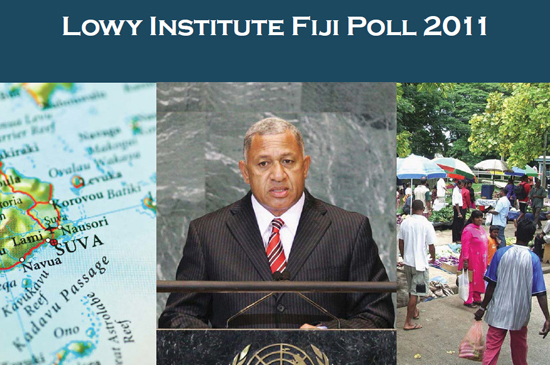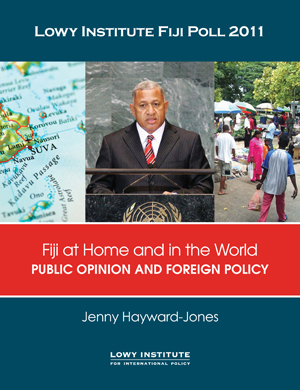
As predicted, those who were disappointed with the results of the Lowy Institute/Tebbutt poll — which found two-thirds of those sampled supportive of the Bainimarama government — have found fault with polls or the poll methodology as a means of accurately determining people's opinions.
They range from Dr Steven Ratuva's concerns that I addressed in an earlier post to those of Samoan Prime M inisterTuilaepa who dismisses all polls as nonsense; to Fiji Trade Unions Congress (FTUC) secretary Felix Anthony who said the poll showed how intimidated people were; fellow unionist Attar Singh of the FICTU who thinks the Lowy Institute should not have commissioned the poll (see separate posting), to Dr Waden Narsey who has written a long critique of the the poll methods on Pacific Scoop, interspersed, as is Wadan's way, with his opinions on the Bainimarama government, the Lowy Institute, Tebbutt Polls, poll experts Fergus Hanson and Sol Leboric (who should hang their heads in shame), Cez Tebbutt, Sharon Smith-Johns, and coup "apologists" Graham Davis and Croz Walsh. Several of the critics, including Dr Narsey, have suggested ulterior motives and or pecuniary motives by the poll sponsors and organisers, "a systematic bias towards favourable outcomes,” and the deliberate reshaping and withholding of unfavourable results. Wadan went one step further and said ordinary people are too uneducated for their poll opinions to mean anything: an interesting view from a democrat and former politician.
Several of the critics, including Dr Narsey, have suggested ulterior motives and or pecuniary motives by the poll sponsors and organisers, "a systematic bias towards favourable outcomes,” and the deliberate reshaping and withholding of unfavourable results. Wadan went one step further and said ordinary people are too uneducated for their poll opinions to mean anything: an interesting view from a democrat and former politician.
None of this is particularly surprising though I was disappointed none gave any credit to an attempt to find out what ordinary people think about the Bainimarama government, given the well-reported claims from the so-called Fiji Democracy and Freedom Movement that Bainimarama has no support and is only holding on to power by the use of force. One might have thought that ordinary people's opinions were important to any discussion on democracy and good governance.
Serious critique
Only Wadan seems to have actually read the full poll report and provided us with a serious critique. I share his concern at the number of questions asked in the time allotted, and the complexity of some of them. I accept that some results are probably less reliable that others. But the results would have had to be very, very different to be wrong on the most important question: support or otherwise for the Bainimarama government.
Readers are invited to read what Dr Narsey has to say, and then look back at this critique of his critique.
First though, some readers may need to know about Dr Narsey's credentials. He is an economist who has been used by the Fiji Bureau of Statistics to analyse data supplied by the Bureau on its Household and Expenditure Surveys, and he analysed data supplied by ECREA from a survey on poverty. As far as I know, he was not involved in the research designs, methodologies or the supervision of the surveys.
In all of this work he has been meticulous in defining terms and describing the statistical tool used, but I can find no reference in his Quantitative Analysis of Poverty in Fiji to the sampling methods used in the 2002-2003 HIES, or any possible shortcomings in the sampling method chosen. This is quite extraordinary.
In Fiji: an Encyclopaedic Atlas, I have expressed considerable concern about their use of “residential areas” as the random sampling frame for reasons that are too detailed to go into here. My only point is that Dr Narsey mentioned nothing of the sampling methods used in his book, which requires explanation and comment, and yet this was his first point of objection to the Lowy Poll.
He criticises the poll's use of urban areas, saying that anti-government opinion is strongest in rural areas. Maybe, maybe not. But rural people are likely to be even more uneducated than those surveyed in the poll.
He infers none too gently they have deliberately deceived readers by concealing their methodology. This is not so. The methodology is spelt out at the end of the report. They clearly state urban areas; they cite the numbers interviewed (an omission in Wadan's report!); their use of 'starting points' is at least as reliable as Dr Narsey's use of "residential areas"; and their use of weights to produce results according to ethnicity, location and so on is no less reliable than Dr Narsey's use of the weighted HIES surveys results.
They make no claim that the poll was truly random, and pointedly place limits on the probability of their results. Wadan does not acknowledge this. I found their explanation of methods far fuller than those explained in Wadan's poverty report.
It is obvious that no sample poll is perfect. The critical question, in the case of this particular poll, is roughly how representative it is likely to be of the opinions of urban people, and, if we discount its wider application to urban Fiji, how honestly did it reflect the opinions of the 1000 people interviewed?
Wadan asks these eight questions. My comment is in italics below.
1. Is the poll genuinely representative of the views of Fiji people?
No, and it does not claim to be. It is a reasonable attempt to disclose the opinions of urban Fijians. See above.
2. Could honest answers be expected in a 'climate of fear'?
The organisers reported no “climate of fear” and Lowry's Jenny Hayward-Jones, who, it should be pointed out, did not like the results, has made no suggestion of any irregularities. (I see from an ABC interview, she is now, for the first time, talking of a "climate of fear.")
Dr Narsey dismissed the results that showed opposition to Australian, Commonwealth and other sanctions, saying that it was "natural" for people for people to defend their country. This really is a most unconvincing explanation. It is also Dr Narsey's country, and the country of those overseas Fijians who approve and wish to see an increase in sanctions even to the point of causing major harm to the economy and the livelihood of its citizens. Why is it also not "natural" for them to oppose sanctions?
3. Could the questions be understood by ordinary Fiji citizens in the time given?
I think too many questions were asked in the time available and the more complex questions (e.g., giving countries a score out a hundred) could be less reliable than direct questions such as 'Is Bainimarama doing a good job?” and "Is Fiji on the right track?" These questions would definitely be understood — in English, Fijian and Fiji Baat.
4. Why did the Lowy Institute ignore the political climate of fear in Fiji?
Dr Narsey assumes ordinary Fijians are living in a climate of fear. This may be so for government opponents but many people returning from visits to Fiji report no such climate. In fact, most say their impression is that most people support what Bainimarama is doing.
The quesions on Australia, the Pacific Islands Forum and the Melanesian Spearhead Group (MSG) were clearly intended to address issues important to the the Lowry Institute that has a place in informing the Australian government on foreign policy issues. In my view, they were of less importance than the questions on Fiji which comprised the other half of the report.
5. Why did the Lowy Institute not report all the tables?
6. Which tables did the Lowy Institute choose not to release?
I not not aware that it did but this is not unusual in survey reports. Itaukei and Indo-Fijian opinions were shown separately on some tables, including the one on Bainimarama. Wadan infers a sinister purpose. I doubt it.
Most poll answers showed a range of responses from approval to disapproval. The range, in question after question, is not consistent with a population living in fear. One-third of the people thought Bainimara's performance was poor, very poor or only average!
7. Who financed the poll and their interests in Fiji?
There is no secret about this. And my quess is that the Lowry Institute expected a very different result. It would to interesting to know what Tuilaepa, Anthony, Singh and Narsey would have said had it been so. I doubt they would have found any fault with the methodology. The criticism of methods is because government opponents do not like the poll results.
8. Links between Tebbutt Research and the Bainimarama regime and functionaries?
I think Dr Narsey is referring to the friendship between Cez Tebbutt and Sharon Smith-Johns, the Permanent Secretary of Information. I agree with Wadan that government must have known this poll was taking place but I see nothing sinister in the influence of the friendship on the poll.
To significantly influence the question outcomes would have required a major effort by all the key people involved. Cez Tebbutt could not have done it alone, even assuming she wanted to. Had there been interference as Wadan clearly claims, it would be the end of Tebbutt Polls in Fiji. Few business men or women would take that risk.
Dr Narsey's innuendos and personal attacks on those involved in the poll detract from his arguments and academic reputation. By all means attack the poll but he should not have attacked the polsters unless he had evidence to support his claims. In doing so he leaves himself wide open to charges of libel, and does little for his reputation as a researcher.
There is a "probability" that his criticism is "95 percent" polemic — and only 5 percent good reseach.
Commentaries on PMC Online's sister website Pacific Scoop:
Dr Wadan Narsey commentary
Graham Davis commentary
Dr Crosbie Walsh commentary (earlier)



